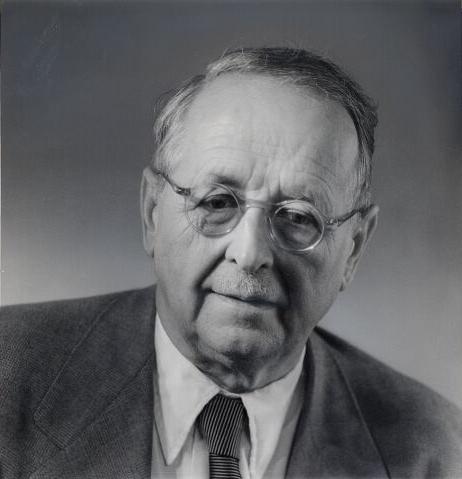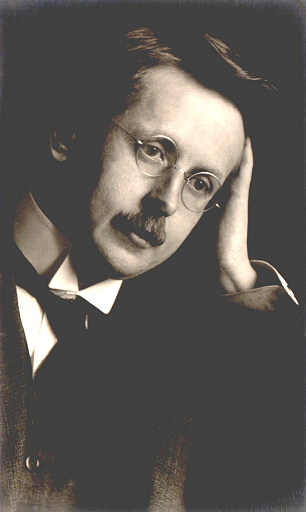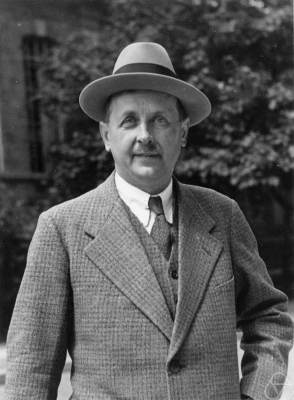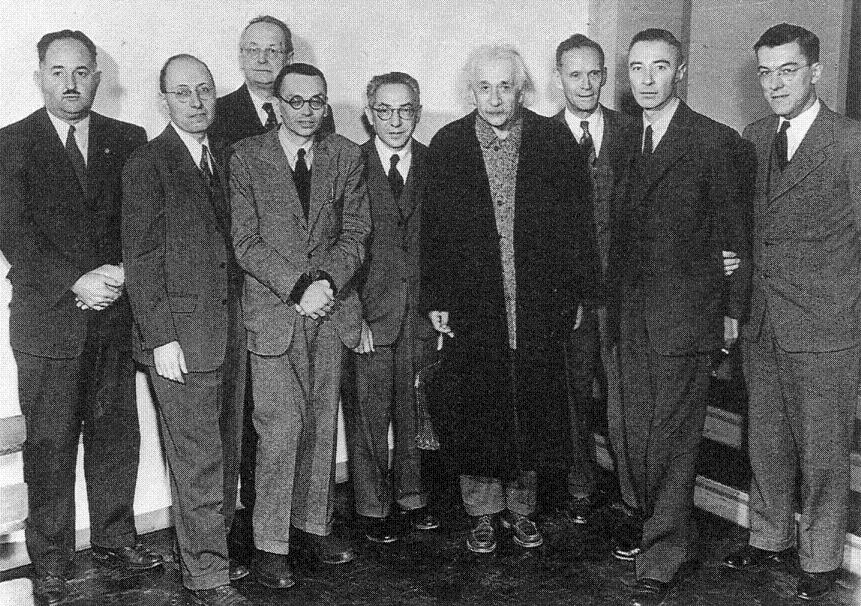<Back to Index>
- Mathematician Hermann Klaus Hugo Weyl, 1885
- Novelist Ivan Sergeyevich Turgenev, 1818
- 1st President of Italy Enrico Roberto De Nicola, 1877
PAGE SPONSOR



Hermann Klaus Hugo Weyl (9 November 1885 – 8 December 1955) was a German mathematician. Although much of his working life was spent in Zürich, Switzerland, and then Princeton, he is associated with the University of Göttingen tradition of mathematics, represented by David Hilbert and Hermann Minkowski. His research has had major significance for theoretical physics as well as pure disciplines including number theory. He was one of the most influential mathematicians of the twentieth century, and an important member of the Institute for Advanced Study during its early years.
Weyl published technical and some general works on space, time, matter, philosophy, logic, symmetry and the history of mathematics. He was one of the first to conceive of combining general relativity with the laws of electromagnetism. While no mathematician of his generation aspired to the 'universalism' of Henri Poincaré or Hilbert, Weyl came as close as anyone. Michael Atiyah, in particular, has commented that whenever he examined a mathematical topic, he found that Weyl had preceded him. Weyl was born in Elmshorn, a town near Hamburg, in Germany, and attended the gymnasium Christianeum in Altona. From 1904 to 1908 he studied mathematics and physics in both Göttingen and Munich. His doctorate was awarded at the University of Göttingen under the supervision of David Hilbert whom
he greatly admired. After taking a teaching post for a few years, he
left Göttingen for Zürich to take the chair of mathematics in
the ETH Zurich, where he was a colleague of Albert Einstein,
who was working out the details of the theory of general relativity.
Einstein had a lasting influence on Weyl who became fascinated by
mathematical physics. Weyl met Erwin Schrödinger in 1921, who was appointed Professor at the University of Zürich. They were to become close friends over time. Weyl
left Zürich in 1930 to become Hilbert's successor at
Göttingen, leaving when the Nazis assumed power in 1933,
particularly as his wife was Jewish. The events persuaded him to move
to the new Institute for Advanced Study in Princeton, New Jersey.
He remained there until his retirement in 1951. Together with his wife,
he spent his time in Princeton and Zürich, and died in Zürich
in 1955. In 1913, Weyl published Die Idee der Riemannschen Fläche (The Concept of a Riemann Surface), which gave a unified treatment of Riemann surfaces. In it Weyl utilized point set topology, in order to make Riemann surface theory more rigorous, a model followed in later work on manifolds. He absorbed L.E.J. Brouwer's early work in topology for this purpose. Weyl,
as a major figure in the Göttingen school, was fully apprised of
Einstein's work from its early days. He tracked the development of relativity physics in his Raum, Zeit, Materie (Space, Time, Matter) from 1918, reaching a 4th edition in 1922. In 1918, he introduced the notion of gauge, and gave the first example of what is now known as a gauge theory. Weyl's gauge theory was an unsuccessful attempt to model the electromagnetic field and the gravitational field as geometrical properties of spacetime. The Weyl tensor in Riemannian geometry is of major importance in understanding the nature of conformal geometry. In 1929 Weyl introduced the concept of the vierbein into general relativity. His overall approach in physics was based on the phenomenological philosophy of Edmund Husserl, specifically Husserl's 1913 Ideen zu einer reinen Phänomenologie und phänomenologischen
Philosophie. Erstes Buch: Allgemeine Einführung in die reine
Phänomenologie (Ideas of a Pure Phenomenology and
Phenomenological Philosophy. First Book: General Introduction).
Apparently this was Weyl's way of dealing with Einstein's controversial
dependence on the phenomenological physics of Ernst Mach. Husserl had reacted strongly to Gottlob Frege's
criticism of his first work on the philosophy of arithmetic and was
investigating the sense of mathematical and other structures, which
Frege had distinguished from empirical reference. Hence there is good
reason for viewing gauge theory as it developed from Weyl's ideas as a
formalism of physical measurement and not a theory of anything
physical, i.e. as scientific formalism. From 1923 to 1938, Weyl developed the theory of compact groups, in terms of matrix representations. In the compact Lie group case he proved a fundamental character formula. These results are foundational in understanding the symmetry structure of quantum mechanics, which he put on a group-theoretic basis. This included spinors. Together with the mathematical formulation of quantum mechanics, in large measure due to John von Neumann, this gave the treatment familiar since about 1930. Non-compact groups and their representations, particularly the Heisenberg group, were also streamlined in that specific context, in his 1927 Weyl quantization,
the best extant bridge between classical and quantum physics to date.
From this time, and certainly much helped by Weyl's expositions, Lie
groups and Lie algebras became a mainstream part both of pure mathematics and theoretical physics. His book The Classical Groups, a seminal if difficult text, reconsidered invariant theory. It covered symmetric groups, general linear groups, orthogonal groups, and symplectic groups and results on their invariants and representations.
Weyl also showed how to use exponential sums in diophantine approximation, with his criterion for uniform distribution mod 1, which was a fundamental step in analytic number theory. This work applied to the Riemann zeta function, as well as additive number theory. It was developed by many others. In The Continuum Weyl developed the logic of predicative analysis using the lower levels of Bertrand Russell's ramified theory of types. He was able to develop most of classical calculus, while using neither the axiom of choice nor proof by contradiction, and avoiding Georg Cantor's infinite sets. Weyl appealed in this period to the radical constructivism of the German romantic, subjective idealist Fichte. Shortly after publishing The Continuum Weyl briefly shifted his position wholly to the intuitionism of Brouwer. In The Continuum, the constructible points exist as discrete entities. Weyl wanted a continuum that
was not an aggregate of points. He wrote a controversial article
proclaiming that, for himself and L.E.J. Brouwer, "We are the
revolution." This article was far more influential in propagating
intuitionistic views than the original works of Brouwer himself. George Pólya and Weyl, during a mathematicians' gathering in Zürich (9 February 1918), made a bet concerning
the future direction of mathematics. Weyl predicted that in the
subsequent 20 years, mathematicians would come to realize the total
vagueness of notions such as real numbers, sets, and countability, and moreover, that asking about the truth or falsity of the least upper bound property of the real numbers was as meaningful as asking about truth of the basic assertions of Georg Hegel on the philosophy of nature. Any answer to such a question would be unverifiable, unrelated to experience, and therefore senseless. However,
within a few years Weyl decided that Brouwer's intuitionism did put too
great restrictions on mathematics, as critics had always said. The
"Crisis" article had disturbed Weyl's formalist teacher Hilbert, but later in the 1920s Weyl partially reconciled his position with that of Hilbert. After about 1928 Weyl had apparently decided that mathematical intuitionism was not compatible with his enthusiasm for the phenomenological philosophy of Husserl,
as he had apparently earlier thought. In the last decades of his life
Weyl emphasized mathematics as "symbolic construction" and moved to a
position closer not only to Hilbert but to that of Ernst Cassirer. Weyl however rarely refers to Cassirer, and wrote only brief articles and passages articulating this position.
